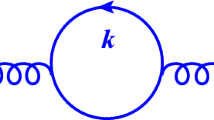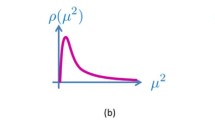Abstract
Sensitivity to the square of the cutoff scale of quantum corrections of the Higgs boson mass self-energy has led many authors to conclude that the Higgs theory suffers from a naturalness or fine-tuning problem. However, speculative new physics ideas to solve this problem have not manifested themselves yet at high-energy colliders, such as the Large Hadron Collider at CERN. For this reason, the role of naturalness as a guide to theory model-building is being severely questioned. Most attacks suggest that one should not resort to arguments involving gravity, which is a much less understood quantum field theory. Another line of attack is against the assumption that there exists a multitude of additional heavy states specifically charged under the Standard Model gauge symmetries. Nevertheless, if we give ground on both of these assaults on naturalness, what remains is a naturalness concern over the prospect of numerous additional spin-zero scalar states in nature. The proliferation of heavy scalars generically destabilizes the Higgs boson mass, raising it to the highest and most remote scalar mass values in nature, thus straining the legitimacy of the Standard Model. The copious use of extra scalars in theory model building, from explaining flavor physics to providing an inflationary potential and more, and the generic expectation of extra scalar bosons in nature argues for the proliferation instability problem being the central concern for naturalness of the Standard Model. Some approaches to solving this problem are presented.
Similar content being viewed by others
Notes
For an historical overview of how understanding developed over time of the quantum corrections of scalars and the Higgs boson see Giudice (2008).
Quantum loop computations of a scalar boson self-energy involve the integration of \(\sim \int d^4q/q^2\) over internal loop momentum \(q\) which is formally allowed to go to \(\infty \). However the integral is quadratically divergent, meaning \(\int d^4q/q^2\propto q_{max}^2\rightarrow \infty \). If we cut off the maximum value allowed for \(q^2\) to be \(q_{max}^2=\varLambda ^2\), we say that \(\varLambda ^2\) is the “cutoff value of the momentum” in the integral.
When precision of speech is requested we can define \(m_\mathrm{weak}=100\, \mathrm{GeV}\). This scale is chosen parametrically to be close to the numerical values of the \(W\) and \(Z\) boson masses \(m_W=80\, \mathrm{GeV}\) and \(m_Z=91\, \mathrm{GeV}\), the top quark mass \(m_t=175\, \mathrm{GeV}\), the Higgs boson mass \(m_H=125\, \mathrm{GeV}\) and the Higgs boson vacuum expectation value \(v=246\, \mathrm{GeV}\), normalized to be the value around which the dynamical Higgs field is expanded in the lagrangian.
The bare mass-squared mass must be large and negative to cancel the “infinite” part induced by the top quark. This is fine as long as the combination of the two terms is positive.
The quantum field theory diagrams that contribute to the cosmological constant scale as the integral \(\sim \int d^4q\) where \(q\) is an internal particle momentum that is formally allowed to go to \(\infty \). We can introduce a cutoff scale for this integral such that \(\int d^4q=\varLambda _{CC}^4\), which we believe should be at least as large as \(\sim M_Z^4\), since we believe we know the theory of nature at energy scales up to at least \(M_Z\). This implies that the cosmological constant would naively be at least \(\varLambda _{CC}^4> M_Z^4\simeq 10^8\,\mathrm{GeV}^4\), or perhaps even \(M_{Pl}^4\sim 10^{72}\,\mathrm{GeV}^4\) if we allow our integral to be cutoff at the known scale of gravity \(M_{Pl}=G_N^{-1/2}\), where \(G_N\) is Newton’s constant of gravity. This constitutes the quantum field theory expectation. However, measurements in cosmology tell us that \(\varLambda _{CC}^4\simeq 10^{-47}\,\mathrm{GeV}^4\), in gross contradiction to our naive expectations. This is still an outstanding problem in physics. See Rugh and Zinkernagel (2002) for a discussion.
The number 45 is counting colors and isospin. \(Q_L\) has 6 (left-handed quarks with 2 isospins, \(u_L\) and \(d_L\), and each has 3 colors), \(u_R\) has 3 (right-handed up quarks with 3 colors), \(d_R\) has 3 (right-handed down quark with 3 colors), \(e_R\) has 1 (right-handed electron with no extra color or isospin factors), and \(L\) has 2 (left-handed leptons with 2 isospins, \(e_L\) and \(\nu _L\)). That makes a total of 15 for each of the three generation of fermions, making a total of 45 fermions.
The Higgs boson field in the Standard Model is a complex electroweak doublet with four degrees of freedom, of which three are absorbed as longitudinal components of the \(Z\), \(W^+\) and \(W^-\) spin-1 bosons, leaving only one physically propagating scalar boson in the spectrum—the recently discovered Higgs boson.
Supersymmetry invariance requires two Higgs boson fields, \(H_u\) and \(H_d\) to give mass to the up and down type fermions separately. It is a feature of supersymmetric theories that when the scale of supersymmetry breaking (i.e., the scale of exotic super partner masses) is above \(m_\mathrm{weak}\) the lightest Higgs boson is an admixture of \(H_u\) and \(H_u\) scalar parts and its properties are remarkably close to the Standard Model Higgs boson (Gunion and Haber 2002).
Even if we assumed overlapping gauge quantum numbers of the Higgs boson with some other exotic scalars, the resulting impact on low scale theory would not destabilize the Higgs mass even if these scalars condensed due to the existence of stable \(D\)-flat directions of the potential.
The Käbler interaction that would allow this is \(\int d^4\theta X^\dagger X H^\dagger _1H_1H^\dagger _2H_2/M_{Pl}^4\) where \(\theta \) is the Grassman variable of superspace and \(X\) is the supersymmetric breaking spurion whose \(F\) term is \(m_\mathrm{weak}M_{Pl}\, \theta ^2\).
References
Aad, G. et al. (ATLAS Collaboration). (2012). Observation of a New Particle in the Search for the Standard Model Higgs Boson with the ATLAS Detector at the LHC. Physics Letters B716, 1–26 [ arXiv:1207.7214].
Arkani-Hamed, N., Dimopoulos, S., & Dvali, G. (1998). The hierarchy problem and new dimensions at a millemeter. Physics Letters, B429, 263–272.
Babu, K. S. (2009). Lectures on flavor physics. arXiv:0910.2948 [hep-ph].
Bagger, J., & Poppitz, E. (1993). Destabilizing divergences in supergravity coupled supersymmetric theories. Physical Review Letters, 71, 2380.
Bardeen, W. A. (1995). On naturalness in the standard model. Procedure Ontake Summer Institute on Particle Physics, 27 Aug - 2 Sep 1995, Ontake Mountain, Japan, Fermilab-Conf-95-391-T.
Baumann, D. (2009). Lectures on Inflation. Proceedings of the Theoretical Advanced Study Institute, Boulder. arXiv:0907.5424.
Chatrchyan, S. et al. (CMS Collaboration). (2012). Observation of a new boson at a mass of 125 GeV with the CMS experiment at the LHC. Physics Letters B716, 30–61 [ arXiv:1207.7235].
Craig, N. (2013). The state of supersymmetry after run I of the LHC. Proceedings of the 11th conference on flavor physics and CP violation (FPCP 2013). 20–24 May 2013, Rio de Janeiro, Brazil.
Csaki, C. (2004). From fields to strings, vol. 2. In M. Shifman (Ed.), Extra dimensions and branes. Singapore: World Scientific.
Dijkstra, et al. (2005). Supersymmetric standard model spectra from RCFT orientifolds. Nuclear Physics B, 710, 3.
Drees, M., Godbole, R. M., & Roy, P. (2004). Theory and phenomenology of sparticles. Singapore: World Scientific.
Ellis, S.A.R., Godbole, R.M., Gopalakrishna, S., Wells, J.D. (2014). Survey of vector-like fermion extensions of the standard model and their phenomenological implications. To be published in JHEP. arXiv:1404.4398.
Farina, M., Pappadopulo, D., Strumia, A. (2013). Modified naturalness principle and its experimental tests. JHEP 1308, 022, arXiv:1303.7244.
Giudice, G. (2008). Naturally Speaking: The Naturalness Criterion and Physics at the LHC. In G. Kane, A. Pierce (eds.), Perspectives on LHC physics, 2008 [ arXiv:0801.2562].
Giudice, G., & Romanino, A. (2004). Split supersymmetry. Nuclear Physics B, B699, 65. [hep-ph/0406088].
de Gouvêa, A., Hernández, D., Tait, T.M.P. (2014). Criteria for natural hierarchies. arXiv:1402.2658.
Gunion, J. F., & Haber, H. E. (2002). The CP conserving two higgs doublet model: The approach to the decoupling limit. Physical Review D, 67, 075019.
Haber, H. E., & Kane, G. L. (1985). The search for supersymmetry: Probing physics beyond the standard model. Physics Reports, 117, 75.
‘t Hooft, G. (1980). Recent developments in gauge theory. New York: Plenum Press.
Hooper, D. (2009). TASI 2008 Lectures on dark matter. Proceedings of the Theoretical Advanced Study Institute, Boulder. arXiv:0901.4090.
Jungman, G., & Kamionkowski, M. (1996). Supersymmetric dark matter. Physics Reports D, D51, 3121.
Martin, S. P. (1998). Supersymmetry primer. textitPerspectives on supersymmetry. World Scientific
Murayama, H. (2000). “Positron analogue” in supersymmetry phenomenology. Proceedings of 1999 ICTP Summer School. arXiv:hep-ph/0002232.
Pomarol, A. (2012). Beyond the standard model. Lectures at the 2010 European School of High-Energy Physics, 20 June - 3 July 2010, Raseborg, Finland. arXiv:1202.1391.
Randall, L., & Sundrum, R. (1999). A large mass hierarchy from a small extra dimension. Physical Review Letters, 83, 3370.
Rugh, S. E., & Zinkernagel, H. (2002). The quantum vacuum and the cosmological constant problem. Studies in the History and Philosophy of Modern Physics, 33, 663–705.
Ross, G. G. (2003). Grand unified theories. New York: Westview Press.
Soni, N. (2013). Searches for physics beyond the standard model at the LHC with the ATLAS detector. Proceedings of the sixth high-energy physics international conference, HEP-MAD 13. Antananarivo, Madagascar (4–10 September 2013).
Susskind, L. (1979). Dynamics of spontaneous symmetry breaking in the Weinberg-Salam theory. Physical Review D, 20, 2619.
Veltman, M.J.G. (1997). Reflections on the higgs system. CERN Yellow Report, 97, issue 05.
Weinberg, S. (2009). Effective field theory, past and future. Proceedings of 6th international workshop on chiral dynamics. Bern, Switzerland, 6 July 2009. [ arXiv:0908.1964].
Wess, J., & Bagger, J. (1992). Supersymmetry and supergravity. Princeton: Princeton University Press.
Acknowledgments
The author wishes to thank G. Giudice, G. Kane, S. Martin, A. Pierce, R. Stuart, and M. Veltman for helpful discussions on these matters.
Author information
Authors and Affiliations
Corresponding author
Rights and permissions
About this article
Cite this article
Wells, J.D. Higgs naturalness and the scalar boson proliferation instability problem. Synthese 194, 477–490 (2017). https://doi.org/10.1007/s11229-014-0618-8
Received:
Accepted:
Published:
Issue Date:
DOI: https://doi.org/10.1007/s11229-014-0618-8




